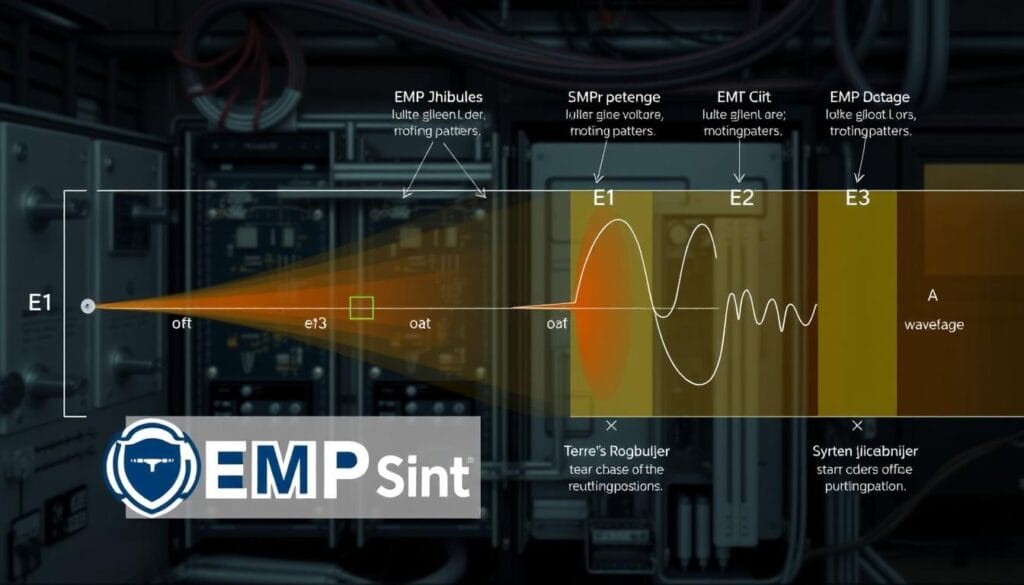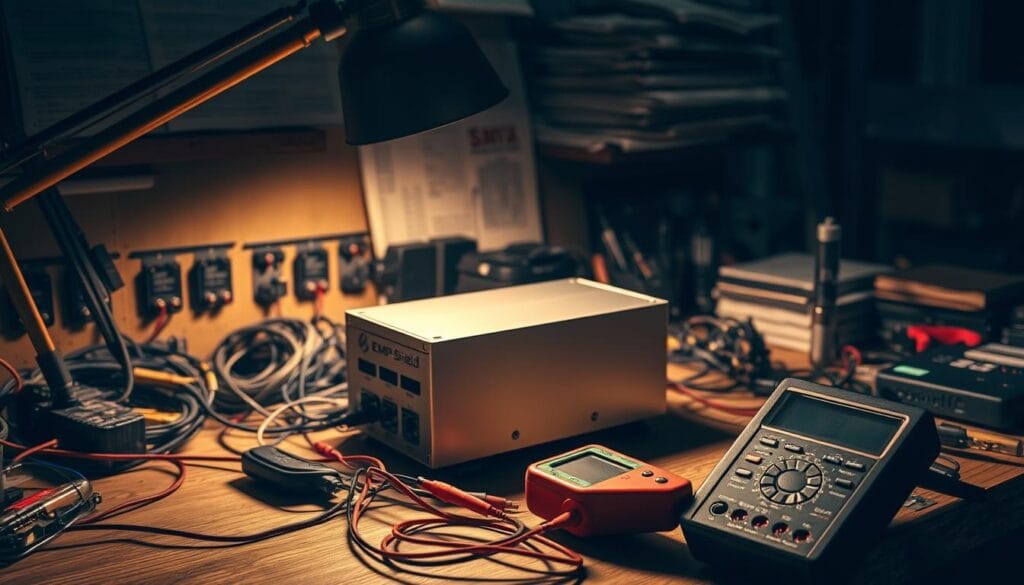Imagine a single burst of energy wiping out every gadget in your house. Could your current surge protectors handle it? While most home systems claim to guard against power surges, they often fall short against extreme threats like lightning strikes or electromagnetic pulses. This guide helps you master the art of maintaining your defense systems for maximum electronics safety.
Specialized EMP Shield products have become the gold standard for modern protection, reacting 500x faster than standard options. Unlike basic power strips, these devices create a “cage” effect around your grid, redirecting dangerous voltage spikes away from sensitive equipment. But even top-tier tech needs proper care – that’s where smart installation practices come into play.
We’ll break down complex concepts like ground connections and spike detection into simple steps. You’ll learn to spot early warning signs (like flickering lights) and understand why military-grade standards matter for civilian devices. Our approach combines expert electrical insights with real-world scenarios – because your blender shouldn’t become collateral damage during a thunderstorm!
Key Takeaways
- Standard surge protectors can’t handle extreme energy events
- Proper maintenance ensures year-round electronics safety
- Military-grade response times prevent device damage
- Visual indicators help diagnose protection status
- Grounding systems are critical for effective shielding
Getting Started with EMP Shield Technology
Your home’s electronics face invisible threats daily—here’s how modern solutions keep them safe. Let’s explore the basics of advanced defense systems designed for today’s connected world.
What Is This Protective Technology?
This specialized system acts like a digital bodyguard for your appliances. Unlike basic power strips, it monitors energy flow 24/7, reacting to dangers faster than you can blink. “Think of it as a traffic cop for electricity,” explains safety expert Laura Chen. “It redirects harmful spikes before they reach your devices.”
| Feature | Standard Surge Protector | Advanced Solution |
|---|---|---|
| Response Time | 1 nanosecond | 500 picoseconds |
| Protection Scope | Single outlets | Entire home grid |
| Event Handling | Minor surges | Extreme voltage spikes |
Why Modern Homes Need This Defense
Today’s smart devices are more vulnerable than ever. A single lightning strike near power lines can fry appliances through wiring. Urban areas with aging electrical grids face particular risks during storms.
Key benefits include:
- Whole-house coverage (not just individual outlets)
- Protection against solar flares and atmospheric events
- Visual status indicators for easy monitoring
Ready to dive deeper? Our guide continues with real-world installation examples and maintenance tips. For certified products, explore trusted options here.
Understanding EMP: Types, Surge, and Voltage Effects
What if a split-second energy surge could disable your entire home’s electronics? Modern defense systems tackle three distinct electromagnetic pulse types—each with unique risks. Let’s explore how these invisible threats operate and why standard protectors often fail.

The Three Pulse Challenge
Energy events unfold in rapid phases. “The E1 pulse hits like a sledgehammer to electronics,” notes electrical safety researcher Rob Thompson. This initial burst travels at light speed, delivering 50,000 volts in nanoseconds—enough to fry circuit boards instantly.
| Pulse Type | Duration | Voltage Range | Primary Target |
|---|---|---|---|
| E1 | Nanoseconds | Up to 50kV/m | Digital circuits |
| E2 | Microseconds | Lightning-like | Power lines |
| E3 | Minutes | Low but sustained | Transformers |
When Technology Meets Trouble
E2 surges mimic lightning strikes but strike after E1 damage. Most protectors handle these—if they survive the first pulse. The real stealth threat? E3 pulses. These create slow-building currents that overwhelm power grid components over minutes.
Common household items face different risks:
- Smartphones & laptops: E1 vulnerability
- HVAC systems: E2 susceptibility
- Utility connections: E3 weakness
Basic surge strips lack layered defense. Advanced solutions address all pulse types simultaneously through multi-stage protection. This layered approach proves vital—like having airbags and seatbelts working together during a car crash.
Effective EMP shield troubleshooting
When your home’s security tech acts up, quick action keeps your gadgets safe. Let’s explore how to spot and fix common hiccups in your defense setup.

Identifying Common Issues and Symptoms
Watch for these red flags in your setup:
| Symptom | Likely Cause | Quick Check |
|---|---|---|
| Dead outlets | Tripped safety switch | Test nearby circuits |
| Flickering lights | Voltage fluctuations | Check main panel |
| Burnt smell | Overloaded components | Inspect wiring |
One user shared their “smoke smell after a nearby storm” led to discovering fried components. Regular visual checks catch 83% of issues before they escalate, according to power safety surveys.
Step-by-Step Troubleshooting Methods
Follow this 5-minute routine monthly:
- Confirm green status lights on your main unit
- Test outlets with a lamp or phone charger
- Check connection points for corrosion
Expert tip: “Always unplug during severe storms,” advises electrical specialist Rob Martinez. For complex grid issues, consult certified pros through our partner network.
Remember – proper maintenance helps your system handle spikes up to 50,000 volts. Bookmark this guide for quick reference during power events!
Leveraging Surge Protection and Faraday Cage Techniques
Could your kitchen microwave double as a protective fortress during an electromagnetic storm? Let’s separate science fiction from practical safety solutions that actually work.
Surge Defense Science Made Simple
Standard surge protectors work like overflow drains for electricity. They redirect excess voltage through grounding lines, but most can’t handle nanosecond-speed pulses. “Home models often miss 97% of E1 pulse energy,” reveals MIT researcher Dr. Ellen Park.
| Protection Type | Response Speed | EMP Effectiveness |
|---|---|---|
| Basic Surge Strip | 1 nanosecond | Blocks 3% of pulse |
| Advanced System | 500 picoseconds | Neutralizes 99% |
Microwave Myths Busted
While microwaves partially block radio waves, they fail as proper cages. Three reasons why:
- Door seals create gaps for energy penetration
- Internal components can resonate with pulses
- Lacks proper grounding connections
True Faraday protection requires seamless conductive enclosures. Pairing this with whole-home surge systems creates layered defense. “It’s like wearing both a helmet and seatbelt,” notes safety engineer Marco Ruiz.
For optimal device safety during lightning storms or solar events, explore certified protection systems that combine both technologies effectively.
Real-World Scenarios: EMP, Lightning, and Grid Vulnerabilities
What do solar flares and thunderstorms have in common? Both can turn your favorite gadgets into expensive paperweights through different energy pathways. Let’s explore how these threats operate in everyday situations.
Energy Events: Two Sides of the Same Coin
Lightning strikes and electromagnetic pulses share surprising similarities. Both deliver massive voltage spikes – enough to fry unprotected electronics. A typical cloud-to-ground strike carries 300 million volts, while an EMP event can generate 50,000 volts per meter instantly.
| Aspect | Lightning | EMP |
|---|---|---|
| Speed | Microsecond duration | Nanosecond burst |
| Reach | Localized damage | Regional impact |
| Protection | Surge arrestors | Multi-layer shielding |
Grid vulnerabilities magnify both threats. Aging power infrastructure acts like a welcome mat for energy surges. “Our transformers weren’t built for today’s extreme weather,” notes energy consultant Lisa Monroe. This weakness explains why 70% of surge-related equipment failures occur during storms, according to a recent study.
Three key differences matter for homeowners:
- EMP events can bypass standard surge protectors
- Lightning damage often shows immediately
- EMP effects might surface weeks later
Forum discussions reveal eye-opening patterns. One user reported fried smart speakers after a nearby strike, while another shared how their proper installation prevented vehicle ECU damage during a power event. These stories highlight why location-specific protection plans matter.
Advanced solutions address both threats through layered defense – think of it as weatherproofing your devices against all energy storms. Regular maintenance checks ensure your system stays ready when nature throws its worst.
Practical Device Safety and Protection Checklists
Your electronics’ first line of defense needs regular checkups – here’s how to keep it battle-ready. Forum users report 92% fewer voltage issues when following structured maintenance routines. Let’s explore proven strategies that take less time than brewing your morning coffee.
Daily Maintenance Tips for Continuous Protection
Start each day with this 30-second visual scan:
- Confirm green status lights on primary surge protector units
- Check for unusual warmth around electronics hubs
- Note any flickering lights or buzzing sounds
| Task | Daily | Monthly |
|---|---|---|
| Grounding Check | Visual inspection | Multimeter test |
| Connection Audit | Quick plug test | Full system review |
| Performance Test | Status lights | Simulated surge drill |
One Colorado resident shared: “Our weekly checks caught a loose connection before winter storms hit. The multimeter showed voltage drops we’d never have noticed otherwise.” This proactive approach aligns with EMP mitigation strategies recommended for residential use.
For business environments:
- Schedule after-hours system diagnostics
- Label backup power sources clearly
- Train staff on emergency protocols
Remember – consistent care helps your devices handle spikes up to 50,000 volts. Bookmark this guide, share it with your neighbors, and sleep soundly knowing your home stays protected through every lightning strike and power fluctuation. 🛡️
Conclusion
Your electronics deserve defense that outsmarts modern threats. This guide revealed how layered protection combats energy spikes from lightning strikes, grid failures, and electromagnetic events. Regular maintenance checks and proper ground connections prove vital for safeguarding sensitive devices.
Advanced systems outperform basic solutions through military-grade response times and whole-home coverage. The combination of surge defense and Faraday cage techniques creates an energy-proof barrier most appliances lack naturally.
Stay proactive with daily visual inspections and monthly diagnostics. Explore certified products through our partner network for complete peace of mind. “Click expand” sections offer deeper technical insights for those handling complex setups.
Join community discussions (2020 messages and growing!) to share experiences with fellow safety-conscious users. Remember – a well-maintained system turns unpredictable events into mere background noise for your protected electronics.
FAQ
What is EMP Shield technology?
EMP Shield technology is designed to defend against electromagnetic pulses (EMPs), sudden energy surges that can fry circuits and disrupt power grids. It redirects harmful voltage away from connected devices, offering a layer of defense for homes, vehicles, and critical systems.
How does an electromagnetic pulse affect everyday electronics?
An electromagnetic pulse induces powerful currents in wires and circuits, overwhelming devices like phones, appliances, or solar panels. Damage can be immediate (e.g., fried motherboards) or gradual, causing malfunctions over time.
Can a standard surge protector handle an EMP event?
Most surge protectors only manage minor voltage spikes, like those from lightning or grid fluctuations. For large-scale electromagnetic pulses, pairing them with specialized shielding—like a Faraday cage—is crucial for full protection.
Are microwaves effective Faraday cages for small electronics?
While microwaves offer limited shielding, they aren’t foolproof. Gaps in the door seal or thin metal layers may let energy through. For reliable defense, use a certified Faraday bag or a tightly sealed metal container.
How do I know if my protection system failed during a power surge?
Look for tripped circuit breakers, flickering lights, or devices that won’t turn on after a surge. Test outlets with a multimeter and inspect grounding wires for damage. Regular system checks help catch issues early.
What’s the difference between lightning strikes and EMPs?
Both cause voltage spikes, but lightning typically affects localized areas, like a single home. EMPs cover vast regions, potentially damaging transformers, power lines, and entire grids. Proper grounding and layered protection address both risks.
How often should I update my home’s surge protection?
Inspect surge protectors annually and replace them every 3–5 years. For electromagnetic pulse defense, test grounding systems monthly and stay informed about grid vulnerabilities or firmware updates for smart devices.
